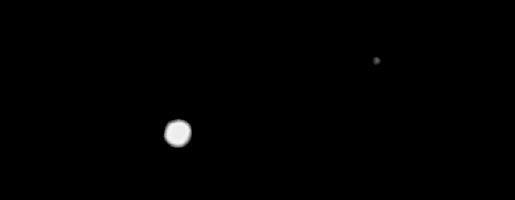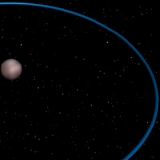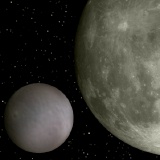 |
|
|
Hubble
Space Telescope image of Pluto and Charon.
|
|
| CHARON - MOON OF PLUTO | |
| Charon is named after the boatman in Greek Mythology who ferries dead souls across the River Styx to the underworld. | |
| Charon was discovered in 1978 by James Christy and Robert Harrington at the U.S Naval Observatory in Flagstaff, Arizona. They were looking at Pluto's occultation of stars to get a more accurate measure of its orbit. Charon was first noticed as a small bulge on photographic images. It was confirmed as a separate body shortly after by French astronomers at the Mauna Kea Observatory, Hawaii. | |
| Orbit | |
| Observations of the Pluto-Charon system show that Charon is in synchronous orbit about Pluto. This means that Charon orbits Pluto in pace with Pluto's rotation, taking 6.387 days to complete one revolution. Charon therefore, can only be seen from one side of Pluto. Charon is also (like our Moon) in a state of synchronous rotation always presenting the same face to Pluto. Seen from the surface of Pluto, Charon always appears in the same place - a moon that does not rise or set. | |
 Charon's orbit. |
|
| Physical properties | |
| Charon's diameter is 1186 kilometres, half the diameter of Pluto. Charon's mass is 1.9 x 1021 kg, or about 0.12 the mass of Pluto. This makes the Pluto-Charon system more like a double planet, than a primary and a satellite. The Pluto-Charon system, is similar to the Earth-Moon system in that the size difference between the primary (the big planet) and its satellite is relatively small. | |
 Comparison between Charon and Earth's Moon. |
|
| Magnetic field | |
| No magnetic field has been detected. | |
| Atmosphere | |
| No atmosphere has been detected. | |
| Interior and formation | |
| In common with the currently favoured idea of how our own Moon formed, Charon may also have begun as a large rogue asteroid which collided with Pluto. The remnants of the collision, together with some of Pluto, ended up in orbit and re-accreted (coalesced) to form Charon. | |
| It is possible that Charon, like Pluto, is differentiated into a layered planet. The heat generated by impacts and radioactive decay may have been sufficient to melt the interior, even though it would have dissipated quite quickly compared to the other terrestrial planets. Overall, Charon is thought to be similar in composition and have similar proportions of materials to Pluto. The density of Charon indicates that it is formed of silicates and contains some organic compounds. | |
| Surface | |
| The crustal configuration of Charon appears to be the opposite of Pluto's. Charon has no methane surface layer but does possess dirty water ice. The methane is thought to have been lost owing to Charon's smaller size and lower gravity. | |
| The surface of Charon is darker than that of Pluto, it is colourless, and less reflective. There are light and dark areas on Charon but no features can be identified. | |
|
|
|